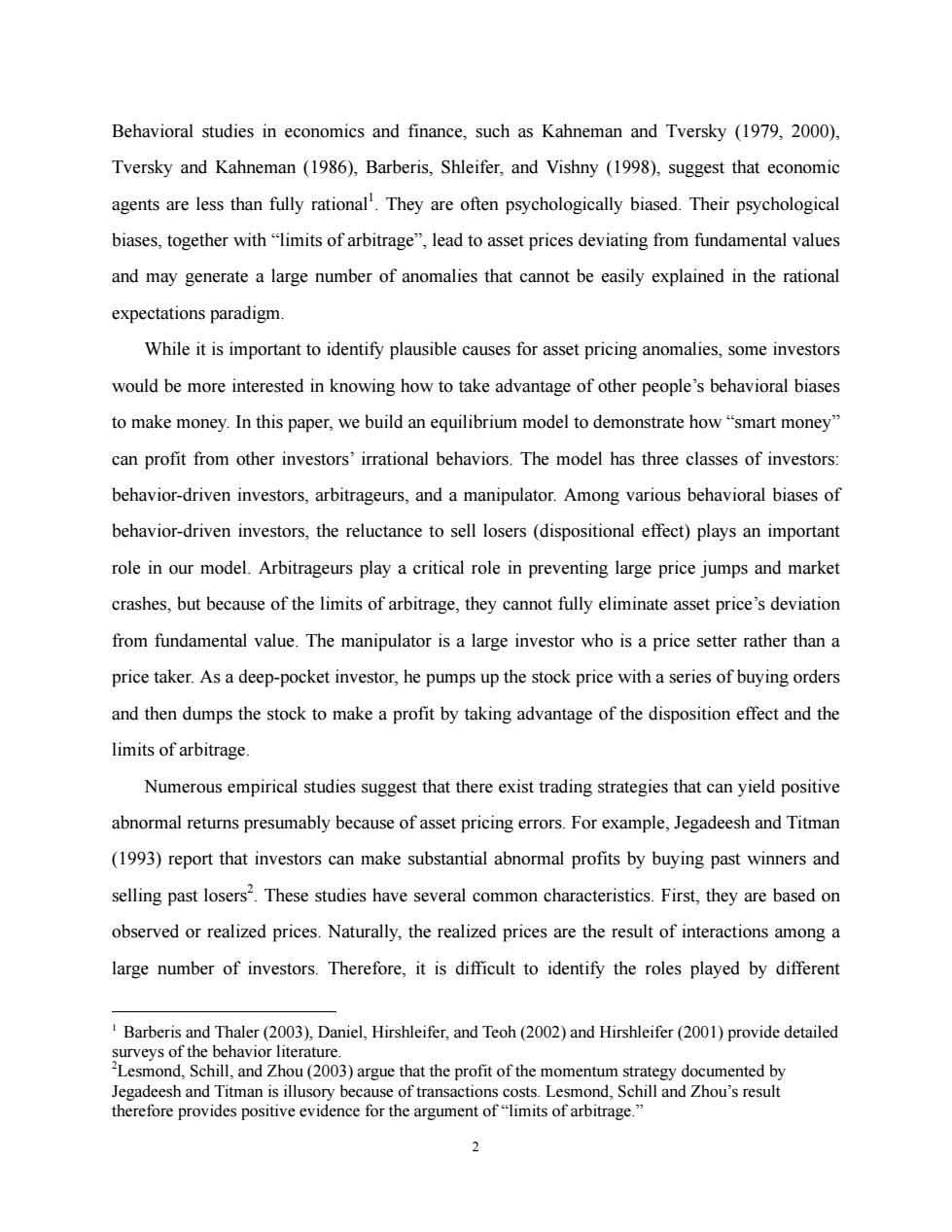正在加载图片...

Behavioral studies in economics and finance,such as Kahneman and Tversky (1979,2000), Tversky and Kahneman (1986),Barberis,Shleifer,and Vishny (1998),suggest that economic agents are less than fully rational'.They are often psychologically biased.Their psychological biases,together with"limits of arbitrage",lead to asset prices deviating from fundamental values and may generate a large number of anomalies that cannot be easily explained in the rational expectations paradigm. While it is important to identify plausible causes for asset pricing anomalies,some investors would be more interested in knowing how to take advantage of other people's behavioral biases to make money.In this paper,we build an equilibrium model to demonstrate how "smart money" can profit from other investors'irrational behaviors.The model has three classes of investors: behavior-driven investors,arbitrageurs,and a manipulator.Among various behavioral biases of behavior-driven investors,the reluctance to sell losers (dispositional effect)plays an important role in our model.Arbitrageurs play a critical role in preventing large price jumps and market crashes,but because of the limits of arbitrage,they cannot fully eliminate asset price's deviation from fundamental value.The manipulator is a large investor who is a price setter rather than a price taker.As a deep-pocket investor,he pumps up the stock price with a series of buying orders and then dumps the stock to make a profit by taking advantage of the disposition effect and the limits of arbitrage Numerous empirical studies suggest that there exist trading strategies that can yield positive abnormal returns presumably because of asset pricing errors.For example,Jegadeesh and Titman (1993)report that investors can make substantial abnormal profits by buying past winners and selling past losers2.These studies have several common characteristics.First,they are based on observed or realized prices.Naturally,the realized prices are the result of interactions among a large number of investors.Therefore,it is difficult to identify the roles played by different Barberis and Thaler(2003),Daniel,Hirshleifer,and Teoh(2002)and Hirshleifer(2001)provide detailed surveys of the behavior literature. Lesmond,Schill,and Zhou(2003)argue that the profit of the momentum strategy documented by Jegadeesh and Titman is illusory because of transactions costs.Lesmond,Schill and Zhou's result therefore provides positive evidence for the argument of"limits of arbitrage." 22 Behavioral studies in economics and finance, such as Kahneman and Tversky (1979, 2000), Tversky and Kahneman (1986), Barberis, Shleifer, and Vishny (1998), suggest that economic agents are less than fully rational1 . They are often psychologically biased. Their psychological biases, together with “limits of arbitrage”, lead to asset prices deviating from fundamental values and may generate a large number of anomalies that cannot be easily explained in the rational expectations paradigm. While it is important to identify plausible causes for asset pricing anomalies, some investors would be more interested in knowing how to take advantage of other people’s behavioral biases to make money. In this paper, we build an equilibrium model to demonstrate how “smart money” can profit from other investors’ irrational behaviors. The model has three classes of investors: behavior-driven investors, arbitrageurs, and a manipulator. Among various behavioral biases of behavior-driven investors, the reluctance to sell losers (dispositional effect) plays an important role in our model. Arbitrageurs play a critical role in preventing large price jumps and market crashes, but because of the limits of arbitrage, they cannot fully eliminate asset price’s deviation from fundamental value. The manipulator is a large investor who is a price setter rather than a price taker. As a deep-pocket investor, he pumps up the stock price with a series of buying orders and then dumps the stock to make a profit by taking advantage of the disposition effect and the limits of arbitrage. Numerous empirical studies suggest that there exist trading strategies that can yield positive abnormal returns presumably because of asset pricing errors. For example, Jegadeesh and Titman (1993) report that investors can make substantial abnormal profits by buying past winners and selling past losers2 . These studies have several common characteristics. First, they are based on observed or realized prices. Naturally, the realized prices are the result of interactions among a large number of investors. Therefore, it is difficult to identify the roles played by different 1 Barberis and Thaler (2003), Daniel, Hirshleifer, and Teoh (2002) and Hirshleifer (2001) provide detailed surveys of the behavior literature. 2 Lesmond, Schill, and Zhou (2003) argue that the profit of the momentum strategy documented by Jegadeesh and Titman is illusory because of transactions costs. Lesmond, Schill and Zhou’s result therefore provides positive evidence for the argument of “limits of arbitrage